At a glance, no one believes this beautiful lake is so scary: What is hidden underneath it?
What is the name of this lake and where in the world is it located?
That's Lake Kivu in Africa.
Lake Kivu, straddling the border of Rwanda and the Democratic Republic of the Congo (Central Africa), offers an incredible landscape, surrounded by towering volcanoes and lush green slopes with rolling hills. plantation of tea, coffee and bananas.
But deep beneath the lake's surface lurks a terrifying threat: Water saturated with methane (CH4), carbon dioxide (CO2) and hydrogen sulfide (H2S). If released, this toxic combination could claim the lives of more than millions of people living along the lake's shores, Time magazine commented.
Currently, the gas-filled water is trapped beneath a heavy layer of salt that prevents it from rising to the surface. But that barrier can easily be broken by an earthquake, a volcanic eruption, or even the increasing pressure of the gases themselves. Lake Kivu is likened to a giant 'time bomb'.
However, in the eyes of scientists and experts, Lake Kivu also contains the potential to provide valuable energy for people living in the vicinity. What have they done to turn this deadly lake into an 'energy mine' serving humans?
Let's find out together!
The most strange lake in the world
Lake Kivu is one of the strangest waters in Africa. An unusual set of properties makes it a fascinating subject for scientists, as well as a site of potential danger and prosperity for the millions of people living nearby.
Kivu is not like most deep lakes. Typically, when the water at the lake's surface cools - winter air temperatures, for example, or snow-bearing rivers in spring - the cold, dense water sinks and the warmer, less dense water rises. up from deeper in the lake. This process, known as convection, typically keeps the surface of deep lakes warmer than their depths.
But at Lake Kivu, this (convection) doesn't happen, making it the most surprising and surprising thing in the eyes of scientists.
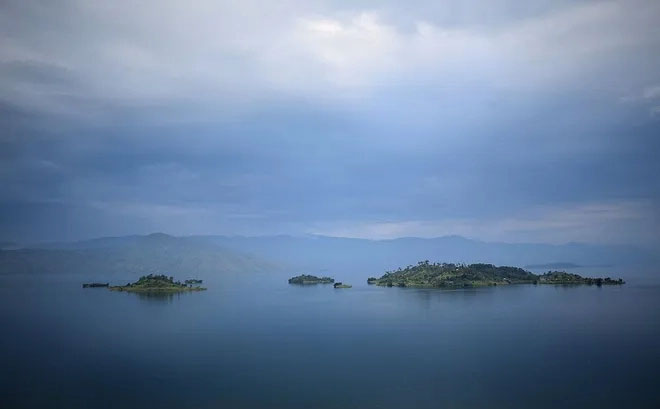
Lake Kivu is seen in the Democratic Republic of the Congo, November 25, 2016.
Stretching across the border between Rwanda and the Democratic Republic of the Congo, Kivu is one of a series of lakes located along the East African Rift Zone (EAR), where the African continent is slowly being split apart by tectonic forces.
The result is thinning of the Earth's crust and triggering volcanic activity, which creates hot springs beneath Kivu, providing it with hot, carbon dioxide-filled water and methane deep in the lake's bottom.
The microorganisms that survive in Lake Kivu use some of the carbon dioxide, as well as organic matter that sinks from above, for energy, which in turn produces additional methane as a by-product. Kivu's great depth - more than 457 meters at its deepest point - creates such great pressure that these gases remain dissolved.
This mixture of water and dissolved gas is denser than water, preventing the convection described above from occurring. The deeper water is also saltier due to silt pouring down from the upper layers of the lake and from minerals in the hot springs, which further increases the density. As a result, according to chemist Sergei Katsev of the University of Minnesota Duluth (USA), Kivu is a lake with many separate layers of water with different densities, between them there are only fragile transition layers.
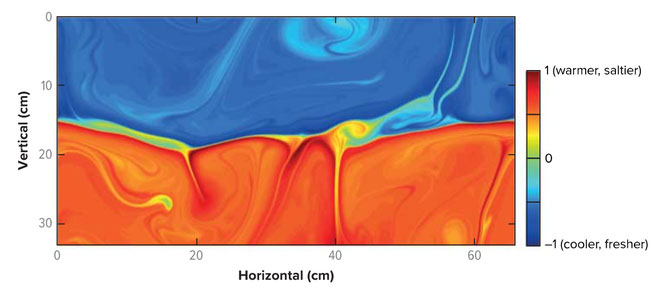
The unique composition of Lake Kivu in Africa prevents mixing commonly found in other deep lakes, leading to an unusual stratification of the water. There is a clear density difference between each layer. The sharp transition between two of those layers is shown here, with lower, warmer, saltier water below (red) and cooler, fresher water above (blue). blue). The boundary between the two layers is only a few centimeters thick. (Source: KM)
Alfred Wüest, a hydrophysicist at the Swiss Federal Institute of Technology in Lausanne, further explains: 'The water layers of Lake Kivu can be roughly separated into two zones: A less dense surface water body. denser, at a depth of about 61 meters - And below that is dense salt water which itself is further stratified. Even so, there is mixing in each layer of water, but they do not interact with each other. Just thinking about the whole body of water lying in Lake Kivu for thousands of years without doing anything can already see the difference in Kivu'.
Lake Kivu is not just an exotic site that attracts scientists. Its unusual stratification and the trapped carbon dioxide, methane, and H2S in the deeper layers of the lake have researchers worried that Kivu could be a disaster waiting to happen.
"Giant gas bomb"
About 2,253km northwest of Kivu, there is a crater lake in Cameroon known as Lake Nyos that also accumulates and retains large amounts of dissolved gas - in this case carbon dioxide - from a mountain vent. fire at the bottom of the lake.
On August 21, 1986, the lethality of that gas tank was horribly demonstrated. Possibly due to landslides, large amounts of water were suddenly displaced, causing dissolved CO2 to rapidly mix with the upper layers of the lake and release a 'gas bomb' into the air. As a result, a large cloud of deadly gas suffocated some 1,800 people living in nearby villages.
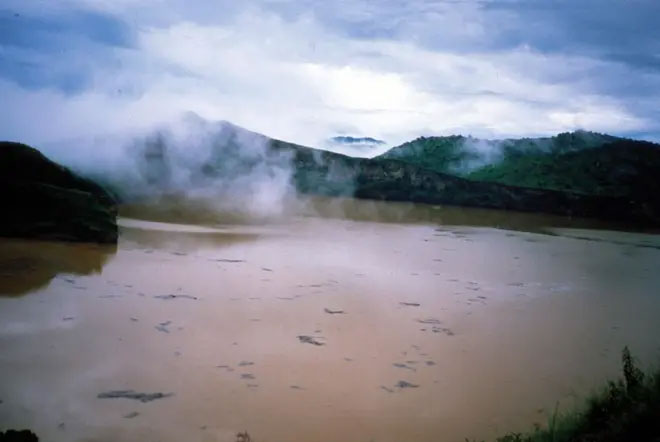
The crater lake in Cameroon is known as Lake Nyos.
Events like these are known as limnic eruptions (or CO2 eruptions), and scientists fear that Lake Kivu may be ripe for a similar, even more dangerous, event.
Because Lake Nyos is a relatively small lake, just over 1.6 km long, less than 1.6 km wide and less than 213 meters deep. Meanwhile, Lake Kivu is 86 km long and 48 km wide.
Because of its size, at Lake Kivu there is the potential for a large, catastrophic limnic eruption where many cubic kilometers of gas will be released into the air.
There were about 14,000 people living near Lake Nyos at the time of the CO2 eruption; More than 2 million people live in the vicinity of Lake Kivu today, including about 1 million residents of the city of Bukavu, in the Democratic Republic of the Congo. If Kivu experienced a CO2 eruption, researcher Sally MacIntyre of the University of California, Santa Barbara (USA) said: 'That event would be catastrophic!'.
This is not just a theoretical concern. Scientists have found what may be evidence of at least one previous CO2 eruption at Lake Kivu, likely between 3,500 and 5,000 years ago, and possibly several recent eruptions. here more. Sediment cores taken from the bottom of Lake Kivu have revealed features known as brown layers that are not unlike the surrounding sediments.
Lachologist Sergei Katsev says these sediments are 'very unusual layers, rich in organic matter', possibly the result of the lake's previous CO2 eruptions.
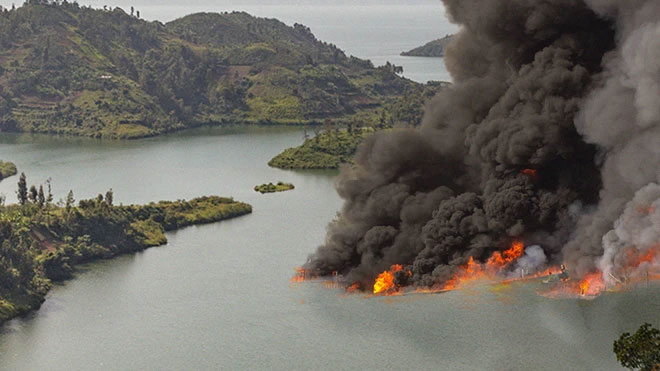
An illustration of Lake Kivu where a CH4 gas explosion occurred.
According to scientists, CO2 eruptions can happen for two reasons. If the water becomes completely saturated with dissolved gases, any additional carbon dioxide or methane that is pumped into the lake will float up and be released into the air.
Eruptions can also be caused when something presses the deep water layer along with its dissolved gases to mix with the layers above, relieving pressure on the gases and allowing them to quickly escape from the solution. fluid and escape, similar to the effect of shaking a can of soft drink and then opening it.
And yet, Lake Kivu is in a seismically active area, so an earthquake that could generate waves in the lake would mix the layers of water enough to release trapped gases.
Climate is also a potential culprit. At least one past eruption detected in the sedimentary record of Lake Kivu was caused by a drought that evaporated enough water from the top of the lake to reduce pressure in the lower layers and release dissolved gases. Low water levels during dry periods can also make Kivu vulnerable to particularly heavy rains. They can discharge enough sediment accumulated from dozens of streams into the lake to cause the layers to mix.
The likelihood of such a chain of events could increase as the planet warms, says Sally MacIntyre. Climate change will bring more rain to East Africa, and 'it will come in the form of more extreme rainfall with larger periods of drought'.
Another possible cause is volcanic activity under Lake Kivu or from surrounding volcanoes, but scientists say the risk of that is low. A 2002 eruption of nearby Mount Nyiragongo did not yield enough material to break through Kivu's bottom layers. And modeling studies have shown that the volcanism beneath the lake won't cause a big enough disruption, says Sally MacIntyre.
Whatever the culprit, the consequences will be the same: The accumulated gases are released from their dissolved state, creating dense clouds of carbon dioxide and methane, which can displace oxygen and suffocate both people and animals living in the vicinity. And if enough methane is released into the air at Kivu, there's an additional risk it could catch fire.
Sergei Katsev said that Lake Kivu is regularly monitored for signs of increased gas concentrations, so a sudden surge "wouldn't surprise us". More than a dozen seismic stations also measure activity near the lake in real time.
In 2001, an effort began to reduce the risk of another disaster at Lake Nyos by drawing water from the lake bottom through a pipe to the surface, where carbon dioxide was released into the air at a rapid rate. safety. Similar efforts are underway at Lake Kivu.
Turn the "deadly lake" into a huge energy mine
As gas concentrations increase in the depths of Kivu, so does the risk.
Hydrophysicist at the Swiss Federal Institute of Technology Alfred Wüest and colleagues found that between 1974 and 2004 carbon dioxide concentrations increased by 10 percent, but of greater concern in Lake Kivu. methane levels, increasing by 15 to 20% over the same period.
However, there may be a way to turn the danger at Lake Kivu into a 'reward'. The same gas - which can cause a deadly natural disaster - also has potential as a source of renewable energy for the region.
For the Rwandan government, methane-rich waters are not only a threat to be mitigated, but also an opportunity. The country, like much of Africa, lacks electricity to meet the needs of its growing population. Mining an estimated 60 billion cubic meters of methane at the lake's depths could power the country at its current rate for 400 years - a prospect that could change in a country with few alternatives for expensive diesel fuel imports.
In 2008, Rwanda launched a pilot program to extract methane from Lake Kivu to burn as natural gas. And in 2019, Rwanda signed a contract to export bottled methane.
And yet, when the project called KivuWatt 'turned the switch' on December 31, 2015, it exceeded expectations, generating power in excess of the planned 25 megawatts from day one.
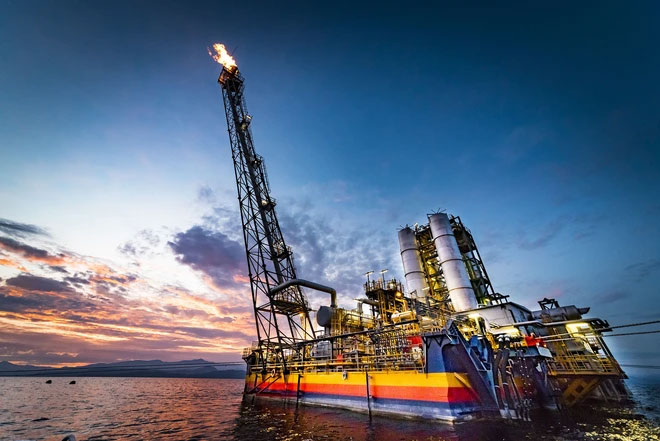
The new KivuWatt power plant - which harnesses methane trapped deep in Lake Kivu - was built by US energy company ContourGlobal.
Clare Akamanzi, CEO of the Rwanda Development Board, told Reuters in 2019 that bottled methane would help cut local reliance on wood and charcoal, the fuels most households rely on. and the tea factory used in this East African country of tens of millions of people.
Methane is extracted for use as fuel, and CO2 is pumped back to the bottom of the lake. "They take this gas, transport it through pipelines onshore, and burn it the way you burn fossil fuels to generate electricity," says Sergei Katsev.
This harvesting can help reduce the risk of gas accumulating in the tank, although it will not be completely eliminated. However, for a lake with many dangers lurking below, any effort is worthwhile and well-recognised.
Once KivuWatt generated 100 megawatts of capacity, it made a significant difference for Rwanda, a developing country moving towards universal access to electricity.
- Be ecstatic with the most beautiful lakes in the world
- 10 lakes are beautiful but can kill people
- The hidden lake - Lake Eyre
- Stand in front of the cold beauty of frozen lakes
- The poetic blue lake that attracts many photographers turned out to be a very dangerous place
- The lake in America changes color beautifully, but it is extremely bad news
- A beautiful volcanic lake in Canada
- The dry park turns into a beautiful lake in the summer
- The strange lake contains millions of rainbow-colored stones
- Spectacular views of frozen lakes in the world
- Lovely pictures of scary animals
- Video: Beautiful waterhole in the lake in Portugal
 Is the magnetic North Pole shift dangerous to humanity?
Is the magnetic North Pole shift dangerous to humanity? Washington legalizes the recycling of human bodies into fertilizer
Washington legalizes the recycling of human bodies into fertilizer Lightning stone - the mysterious guest
Lightning stone - the mysterious guest Stunned by the mysterious sunset, strange appearance
Stunned by the mysterious sunset, strange appearance